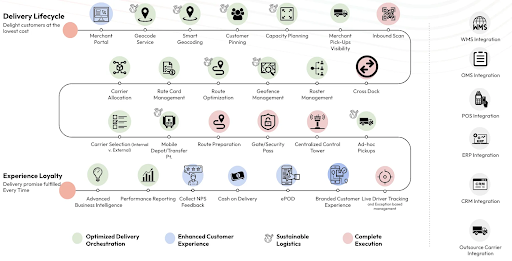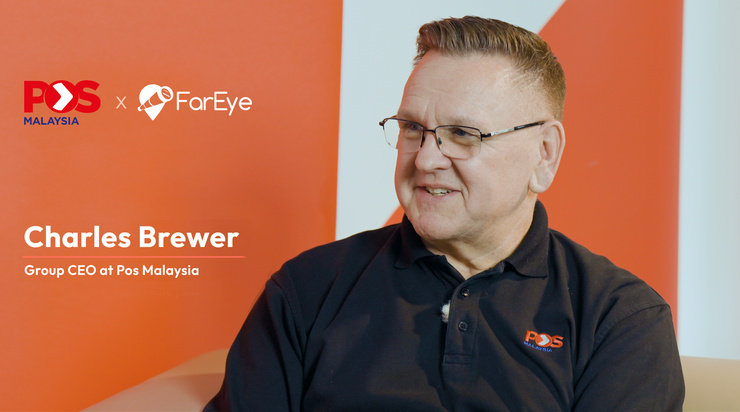- Big & Bulky
Why GPS Route Optimization is Essential for Scalable Logistics Operations
Table of Contents
- What is GPS Route Optimization?
- Rethinking Scale: The True Challenge in Logistics Growth
- The Role of GPS Route Planning in Scalable Fleet Management
- Smarter Delivery Networks: How GPS Route Optimization Drives Efficiency
- Overcoming Daily Hurdles: GPS Route Optimization in Action
- The Economics of Scaling: Controlling Costs with Intelligent Dynamic Routing
- Sustainability and Compliance: The New Imperatives in Fleet Operations
- The Technology Edge: AI, Machine Learning, and GPS Fleet Tracking Route Optimization
- Why FarEye Sets the Standard for GPS Route Optimization
- Building Resilience and Agility with GPS Route Optimization
- FAQ

Supply chains aren’t slowing down. Logistics networks are busier than ever, with trucks handling more than 60% of all surface trade along national borders. Every year, more goods move, more delivery promises are made, and the pressure on dispatchers grows.
The line between coping and competing is thinner than it looks today; it’s about finding gains in how information is used. That’s the real value GPS route optimization brings to the table: it’s the engine for true, repeatable scale.

What is GPS Route Optimization?
GPS route optimization is more than just navigation; it’s the intelligent process of using live data, algorithms, and historical patterns to plan and execute the most efficient, cost-effective routes for your fleet. Unlike basic GPS route planning, optimization adapts routes instantly based on dynamic factors like traffic, weather, delivery windows, and compliance requirements.
With GPS route planning software, dispatchers gain dynamic routing, real-time fleet visibility, and scalable dispatch capabilities, delivering results that scale with business growth.
Rethinking Scale: The True Challenge in Logistics Growth
Growth in logistics is rarely linear. Taking on new clients or moving into fresh markets doesn’t just mean running extra vehicles; it means juggling a swarm of variables all at once. Traffic, driver shifts, vehicle types, order urgency, time windows, and ever-changing regulations come into play.
What once could be sorted out with a few calls and some sticky notes turns into a tangle that’s hard to manage and harder to explain when things go wrong. That’s where manual planning starts falling apart. The real challenge is to keep things running smoothly as everything gets bigger, faster, and more complex.
The Role of GPS Route Planning in Scalable Fleet Management
Keeping a fleet under control depends on planning, not just once but constantly. GPS route planning has made this possible for operations that need to scale up and still keep their edge.
Unlike consumer apps, enterprise-grade platforms sort through a mountain of constraints: time slots, load limits, vehicle types, driver hours, and even specific customer requests. The result is a smarter backbone for daily deliveries that can grow as fast as your business does.
Smarter Delivery Networks: How GPS Route Optimization Drives Efficiency
There’s a reason the most successful logistics operators invest in robust route optimization. When algorithms handle the heavy lifting, a dispatcher can handle more volume without working around the clock or rolling the dice on timing.
- Tighten Delivery Windows
From next week to next hour, better routes mean tighter, more predictable ETAs.
- Maximize Fleet Utilization
Ensure every vehicle is assigned the optimal workload with real-time fleet tracking and insights. Drivers aren’t sitting idle, and trucks don’t run empty back to base.
- Automate Load Planning
Orders fit together like puzzle pieces, taking pressure off everyone involved.
This is what creates a sense of control on days when the order board is packed.
Overcoming Daily Hurdles: GPS Route Optimization in Action
Every planner knows how quickly a day can unravel. Accidents, sudden detours, and order cancellations are all part of the job. But it doesn’t have to mean chaos. GPS route optimization reacts to these hurdles in real-time, not after the damage is done.
- Dynamic Routing
Deliveries are reshuffled on the fly, protecting customer commitments.
- Real-Time Tracking
Managers see where every vehicle is, no guessing, no endless check-in calls.
- Territory Planning
Historical delivery data is used to carve out manageable zones, keeping travel time low and workloads fair.
It’s less about putting out fires and more about preventing them from starting that brings control.
The Economics of Scaling: Controlling Costs with Intelligent Dynamic Routing
Costs can spiral fast when growth outpaces planning. GPS route planning offers a tight grip on those risks:
- Fuel & Maintenance
Less wasted mileage means real savings at the pump and slower vehicle wear.
- Labor Efficiency
Drivers finish more jobs per shift, keeping overtime to a minimum and morale high.
- Asset Use
By getting more out of each vehicle, companies can hold off on expensive fleet expansions.
That’s why dynamic routing is often the difference between profitable growth and a margin squeeze.
Sustainability and Compliance: The New Imperatives in Fleet Operations
There’s growing scrutiny of how fleets impact the environment. Route optimization makes it easier for companies to move towards green logistics without a massive overhaul.
- Lower Emissions
Cutting out wasteful driving directly shrinks the carbon footprint.
- EV and Green Routing
Solutions now optimize for electric vehicles, factoring in range and charging spots automatically.
- Compliance
Platforms account for everything from truck weights to breaking rules, lowering risk and hassle.
These are no longer optional boxes to tick. They’re what shippers and regulators expect.
The Technology Edge: AI, Machine Learning, and GPS Fleet Tracking Route Optimization
What’s powering the latest jump in results? It’s not just GPS signals; it’s what happens with all that data.
- Predictive Analytics
Today’s systems spot trouble before it happens, flagging likely bottlenecks and suggesting alternatives.
- Continuous Optimization
As soon as traffic changes or the weather turns, routes adjust. No lag, no missed opportunities.
- Data-Driven Learning
Each delivery teaches the platform a bit more, making future planning sharper and more reliable.
Operations become adaptive, not just responsive.
Why FarEye Sets the Standard for GPS Route Optimization
Among modern platforms, FarEye stands out for its end-to-end approach. Its AI-driven dynamic routing engine looks beyond today’s traffic, baking in historical trends, weather, delivery types, and even the needs of electric fleets.
APIs let FarEye slide straight into existing OMS and TMS systems, so new workflows don’t mean a new headache.
- Dynamic Optimization: Traffic, cancellations, and last-minute orders are handled without missing a beat.
- Configurable APIs: FarEye adapts to the way you work, not the other way around.
- Compliance: All local and federal rules, like HOS and DoT, are built into every plan.
- Sustainability: Whether it’s planning greener routes or managing EVs, FarEye puts environmental gains within reach.
What this means on the ground: dispatchers can act quickly, managers can spot trends, and the operation as a whole moves with far less friction.
Building Resilience and Agility with GPS Route Optimization
Scaling logistics doesn’t just call for more resources. It calls for sharper, more flexible processes. GPS route optimization is what gives teams the freedom to say yes to more without losing control over costs or customer promises.
As the bar keeps rising, the right platform isn’t just helpful; it’s how you stay ahead. FarEye’s approach puts data, speed, and smart automation in the driver’s seat, letting organizations build supply chains that stand up to both growth and uncertainty.
Want to unlock scalable logistics with GPS route optimization? Schedule a demo today..
FAQ
- What is the difference between GPS route planning and GPS route optimization?
GPS route planning determines a possible route; GPS route optimization finds the best, most efficient option, accounting for real-time data and business constraints. - Can this system handle live order changes?
Yes. With platforms like FarEye, dynamic routing and real-time fleet visibility enable instant adjustments as new orders or disruptions occur. - How does GPS fleet tracking route optimization support growth?
It provides dispatchers with the tools to monitor, analyze, and optimize every trip, making it easier to scale without sacrificing quality or compliance.
Source:

Komal Puri is a seasoned professional in the logistics and supply chain industry. As the AVP of Marketing and a subject matter expert at FarEye, she has been instrumental in shaping the industry narrative for the past decade. Her expertise and insights have earned her numerous awards and recognition. Komal’s writings reflect her deep understanding of the industry, offering valuable insights and thought leadership.
Let's Talk to Our Experts and Optimize Your Deliveries Today!
An expert from our team will reach out within 24 hours
Related resources


